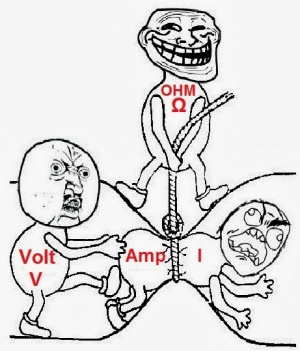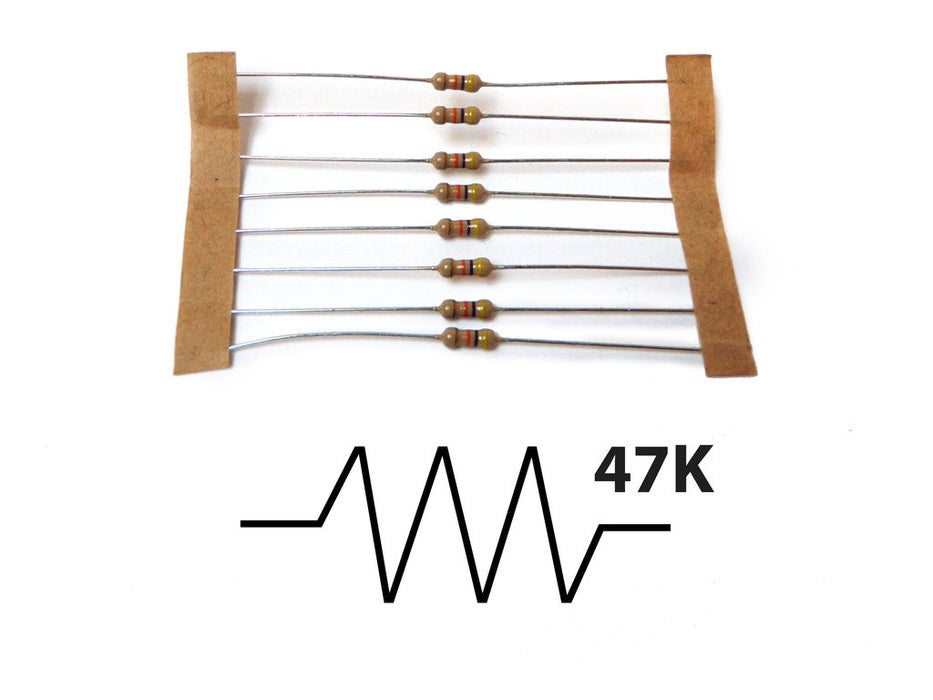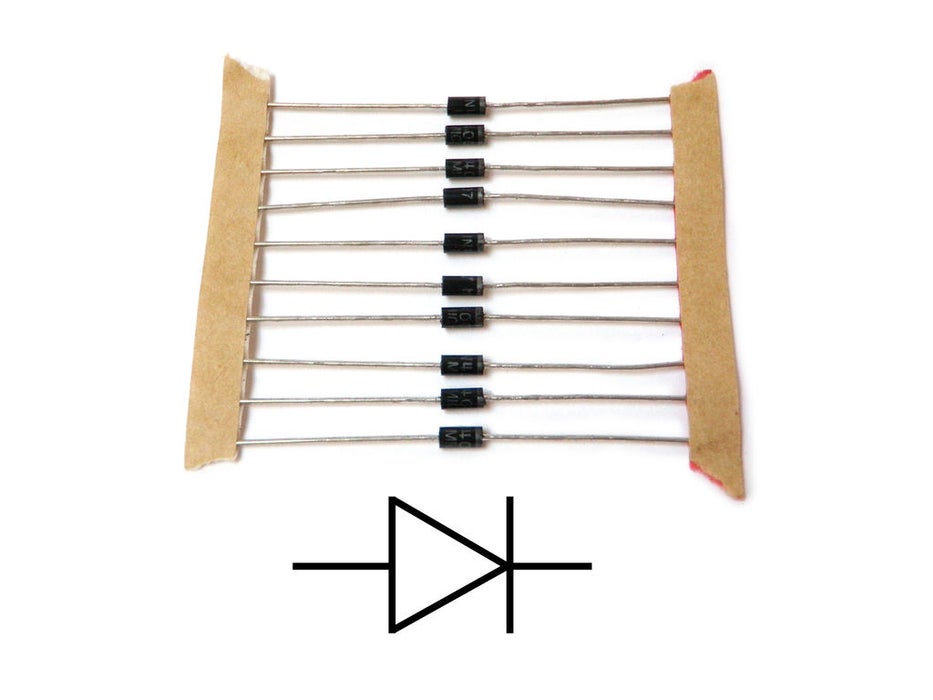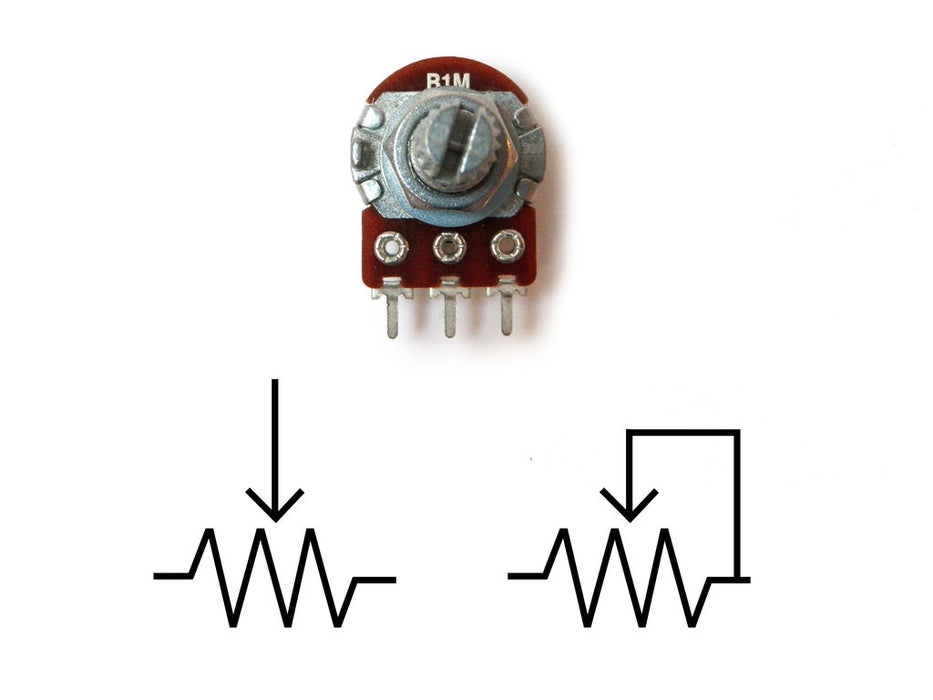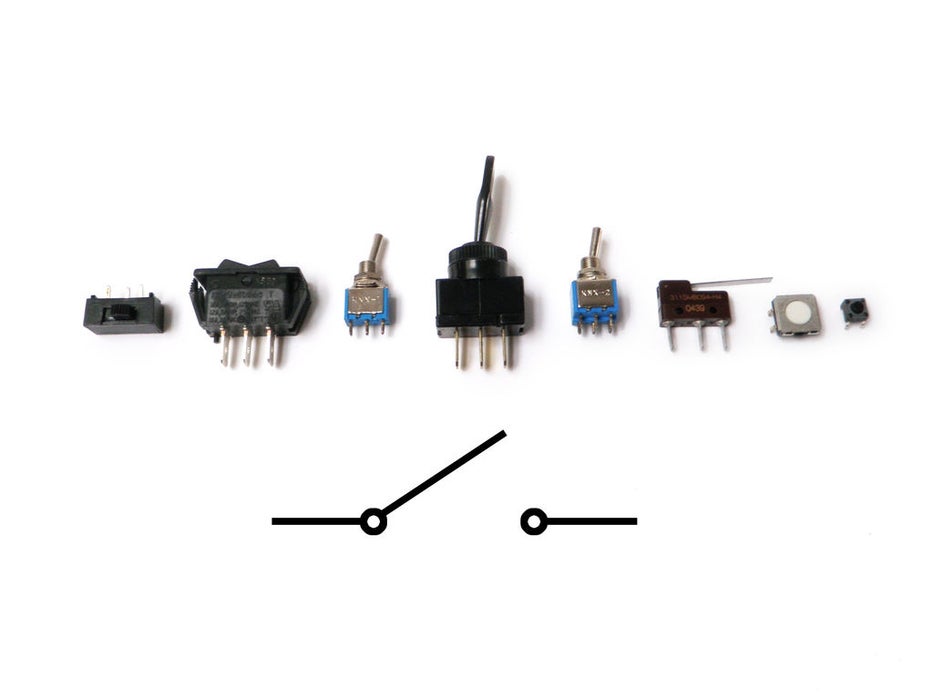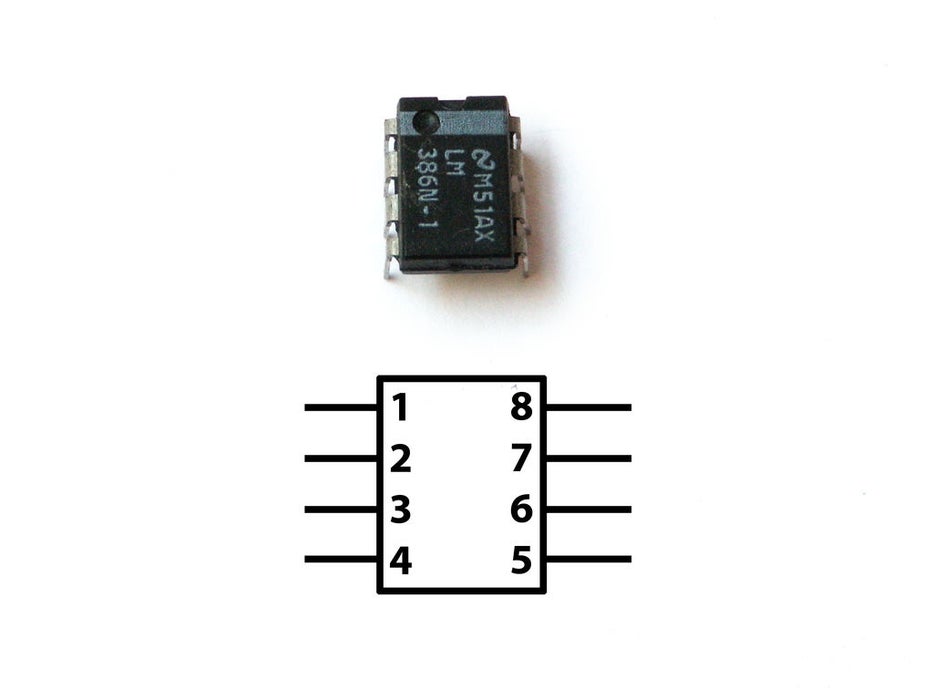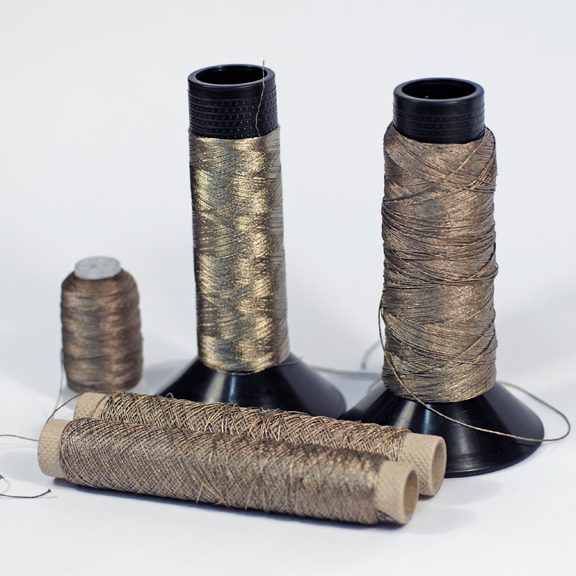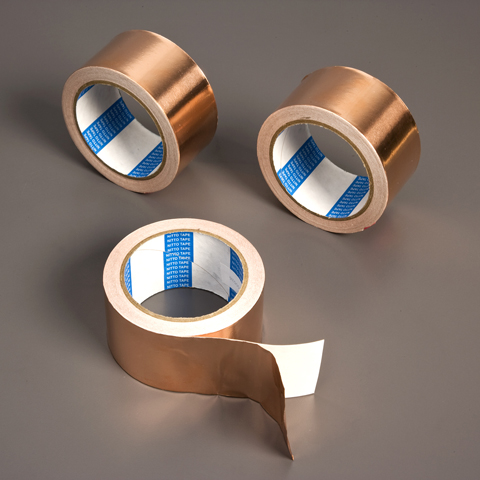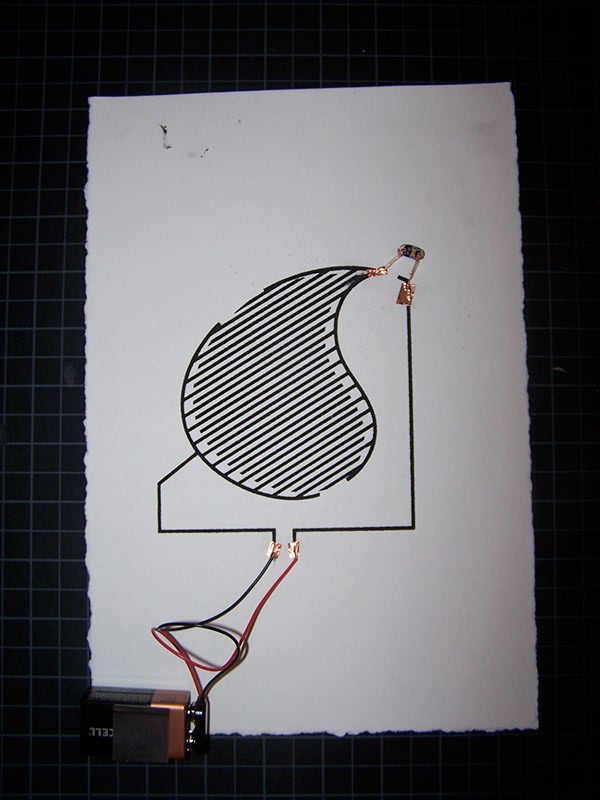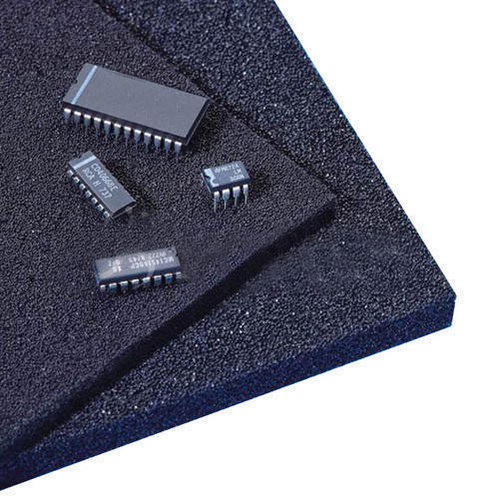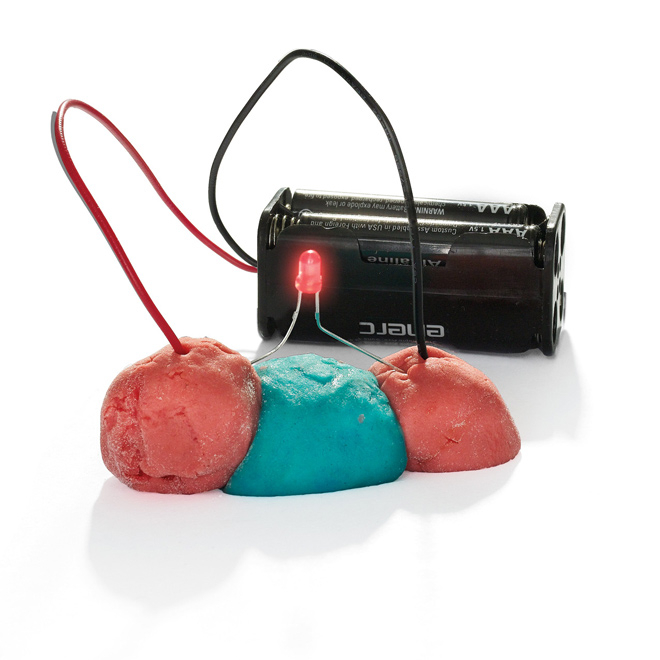Difference between revisions of "An Introduction to Wearable Electronics"
| (12 intermediate revisions by one other user not shown) | |||
| Line 124: | Line 124: | ||
[[file:Potentiometers.jpg]] | [[file:Potentiometers.jpg]] | ||
| + | |||
| + | Potentiometers are variable resistors. In plain English, they have some sort of knob or slider that you turn or push to change resistance in a circuit. If you have ever used a volume knob on a stereo or a sliding light dimmer, then you have used a potentiometer. | ||
| + | |||
| + | Potentiometers are measured in ohms like resistors, but rather than having color bands, they have their value rating written directly on them (i.e. "1M"). They are also marked with an "A" or a "B, " which indicated the type of response curve it has. | ||
| + | |||
| + | Potentiometers marked with a "B" have a linear response curve. This means that as you turn the knob, the resistance increases evenly (10, 20, 30, 40, 50, etc.). The potentiometers marked with an "A" have a logarithmic response curve. This means that as you turn the knob, the numbers increase logarithmically (1, 10, 100, 10,000 etc.) | ||
| + | |||
| + | Potentiometers have three legs as to create a voltage divider, which is basically two resistors in series. When two resistors are put in series, the point between them is a voltage that is a value somewhere between the source value and ground. | ||
| + | |||
| + | For instance, if you have two 10K resistors in series between power (5V) and ground (0V), the point where these two resistors meet will be half the power supply (2.5V) because both of the resistors have identical values. Assuming this middle point is actually the center pin of a potentiometer, as you turn the knob, the voltage on the middle pin will actually increase towards 5V or decrease toward 0V (depending which direction that you turn it). This is useful for adjusting the intensity of an electrical signal within a circuit (hence its use as a volume knob). | ||
| + | |||
| + | This is represented in a circuit as a resistor with an arrow pointing towards the middle of it. | ||
| + | |||
| + | If you only connect one of the outer pins and the center pin to the circuit, you are only changing the resistance within the circuit and not the voltage level on the middle pin. This too is a useful tool for circuit building because often you just want to change the resistance at a particular point and not create an adjustable voltage divider. | ||
| + | This configuration is often represented in a circuit as a resistor with an arrow coming out of one side and looping back in to point towards the middle. | ||
=== LEDs === | === LEDs === | ||
[[file:LEDs.jpg]] | [[file:LEDs.jpg]] | ||
| + | |||
| + | LED stands for light emitting diode. It is basically a special type of diode that lights up when electricity passes through it. Like all diodes, the LED is polarized and electricity is only intended to pass through in one direction. | ||
| + | |||
| + | There are typically two indicators to let you know what direction electricity will pass through and LED. The first indicator that the LED will have a longer positive lead (anode) and a shorter ground lead (cathode). The other indicator is a flat notch on the side of the LED to indicate the positive (anode) lead. Keep in mind that not all LEDs have this indication notch (or that it is sometimes wrong). | ||
| + | |||
| + | Like all diodes, LEDs create a voltage drop in the circuit, but typically do not add much resistance. In order to prevent the circuit from shorting, you need to add a resistor in series. To figure out how large of a resistor you need for optimum intensity, you can use this online LED calculator to figure out how much resistance is needed for a single LED. It is often good practice to use a resistor that is slightly larger in the value than what is returned by [[http://led.linear1.org/1led.wiz/ calculator]]. | ||
| + | |||
| + | '''Typically, the forward voltage of an LED is between 1.8 and 3.3 volts. It varies by the color of the LED. A red LED typically drops 1.8 volts.''' | ||
| + | '''For most purposes, the exact value is not critical and you can use 2V for red, yellow and green, or 4V for blue and white LEDs.''' | ||
| + | |||
| + | '''The LED current must be less than the maximum permitted for your LED. For standard 5mm diameter LEDs the maximum current is usually 20mA, ''' | ||
| + | '''so 10mA or 15mA are suitable values for many circuits. The current must be in amps (A) for the calculation, to convert from mA to A divide the current in mA by 1000.''' | ||
| + | |||
| + | You may be tempted to wire LEDs in series, but keep in mind that each consecutive LED will result in a voltage drop until finally there is not enough power left to keep them lit. As such, it is ideal to light up multiple LEDs by wiring them in parallel. However, you need to make certain that all of the LEDs have the same power rating before you do this (different colors often are rated differently). | ||
| + | |||
| + | LEDs will show up in a schematic as a diode symbol with lightning bolts coming off of it, to indicate that it is a glowing diode. | ||
===Buttons and Switches === | ===Buttons and Switches === | ||
[[file:Switches.jpg]] | [[file:Switches.jpg]] | ||
| + | |||
| + | |||
| + | A switch is basically a mechanical device that creates a break in a circuit. When you activate the switch, it opens or closes the circuit. This is dependent on the type of switch it is. | ||
| + | |||
| + | Normally open (N.O.) switches close the circuit when activated. | ||
| + | |||
| + | Normally closed (N.C.) switches open the circuit when activated. | ||
| + | |||
| + | As switches get more complex they can both open one connection and close another when activated. This type of switch is a single-pole double-throw switch (SPDT). | ||
| + | |||
| + | If you were to combine two SPDT switches into one single switch, it would be called a double-pole double-throw switch (DPDT). This would break two separate circuits and open two other circuits, every time the switch was activated. | ||
=== Batteries and Power Supply=== | === Batteries and Power Supply=== | ||
[[file:Batteries.jpg]] | [[file:Batteries.jpg]] | ||
| + | |||
| + | A battery is a container which converts chemical energy into electricity. To over-simplify the matter, you can say that it "stores power." | ||
| + | |||
| + | By placing batteries in series you are adding the voltage of each consecutive battery, but the current stays the same. For instance, a AA-battery is 1.5V. If you put 3 in series, it would add up to 4.5V. If you were to add a fourth in series, it would then become 6V. | ||
| + | |||
| + | By placing batteries in parallel the voltage remains the same, but the amount of current available doubles. This is done much less frequently than placing batteries in series, and is usually only necessary when the circuit requires more current than a single series of batteries can offer. | ||
| + | |||
| + | It is recommended that you get a range of AA battery holders. For instance, I would get an assortment that holds 1, 2, 3, 4, and 8 AA batteries. | ||
=== Breadboards === | === Breadboards === | ||
| − | == | + | OK, first, what's with the name....bread board? Bread, like in food? |
| + | Well yes, kind of. | ||
| + | <br> | ||
| + | [[File:Breadboard.jpg ]] | ||
| + | |||
| + | This terminology goes way back in the days. | ||
| + | Generally, you would mount electronic components to a piece of wood (the actual "breadboard"), and do all the wiring with point-point wire and the components just hanging between the various devices. | ||
| + | <br> | ||
| + | [[File:Breadboardreal.jpg]] | ||
| + | <br> | ||
| + | The story goes that an engineer had an idea for a vacuum tube device late one night. Looking around the house, the only base for his prototype that he found was indeed his wife's breadboard, from the breadbox. | ||
| + | <br> | ||
| + | [http://www.youtube.com/watch?feature=player_embedded&v=HrG98HJ3Z6w A video by the Make magazine people ] | ||
| + | <br> | ||
| + | Ok, but why do we need to breadboard? | ||
| + | <br> | ||
| + | '''Well, they are useful for making temporary circuits and prototyping, and they require absolutely no soldering.''' | ||
| + | <br> | ||
| + | '''Prototyping is the process of testing out an idea by creating a preliminary model from which other forms are developed or copied,''' | ||
| + | '''and it is one of the most common uses for breadboards.''' | ||
| + | <br> | ||
| + | The best way to explain how a breadboard works is to take it apart and see what’s inside.<br> | ||
| + | [[File:Breadboard02.jpg]] | ||
| + | <br><br> | ||
| + | connections lines are connected like this | ||
| + | <br> | ||
| + | [[File:Breadboard03.jpg]] | ||
| + | |||
| + | <br> | ||
| + | |||
=== Integrated Circuits === | === Integrated Circuits === | ||
[[file:Integrated Circuits.jpg]] | [[file:Integrated Circuits.jpg]] | ||
| + | |||
| + | An integrated circuit is an entire specialized circuit that has been miniaturized and fit onto one small chip with each leg of the chip connecting to a point within the circuit. These miniaturized circuits typically consist of components such as transistors, resistors, and diodes. | ||
| + | [[Integrated Circuits]] | ||
= Soft Materials = | = Soft Materials = | ||
| + | Intro: | ||
| + | This is an introduction to working with soft electronics. Combining and entwining circuits and fabrics. | ||
| + | We will go through the fundamental knowledge of electricity and how we can use it in various ways to make soft interfaces. | ||
| + | |||
| + | |||
| + | ==conductive== | ||
| + | When we work with electronics, we obviously need electricity to power our work, so a crucial component of our work are conductive materials, or conductors. | ||
| + | Conductors are substances that allow the flow of electrical current through them. The most common and well-known conductors of electrical current are metals. Both conductivity and resistivity are properties of conductors. | ||
| + | As we focus on wearables, it will be in our interest to move further than using simply wire, that is most commonly used in electrical circuits and explore other conductive materials. | ||
| + | ===conductive and resisitive=== | ||
| + | |||
| + | Simplified explanation: they are opposites! | ||
| + | |||
| + | Resistivity - the amount of opposition to electrical flow | ||
| + | |||
| + | Conductivity - how easy it is for an electrical flow | ||
| + | |||
| + | ===fabrics=== | ||
| + | Conductive fabrics can be used as traces and wires are used in a circuit.<br> | ||
| + | It can be cut by hand, lasercut, cut with a vinyl cutter. Lasercutting can leave smokey traces on the material and slightly melted edges. Using a vinyl cutter leaves the fabric cleaner.<br> | ||
| + | Interfacing it to another fabric can be done via interfacing adhesive (such as heat n bond, that gives clean and neat results), fabric glue (it is more difficult to work with in complex shapes), sawing. | ||
| + | |||
| + | [[File:Fabrics.jpeg]] | ||
| + | |||
| + | ===thread=== | ||
| + | Conductive threads are usually manufactured for anti-static, electromagnetic shielding, intelligent textiles, wearable technology, data transfer and heating purposes. Most threads are metalised with an alloy of various metals, which can include silver, copper, tin and nickel. The core is normally cotton or polyester. | ||
| + | Conductive threads are mostly non insulated and sewing them tightly to metal usually makes for a good connection, though this connection tends to loosen over time where movement occurs. One way of avoiding this is to include a squishy material, such as stretch conductive fabric underneath the stitches, or a non-conductive material, so long as it does not obstruct the electrical connection. <br> | ||
| + | |||
| + | [[File:Conductivethreadgroup.jpg]] | ||
| + | |||
| + | ===velcro=== | ||
| + | Velcro is the brand name for fabric Hook and Loop fasteners. conductive velcro is highly conductive and good for making switches or connections that might need to be opened and closed. <br> | ||
| + | [[File:ADA-1324-2-684x456.jpg]] | ||
| + | |||
| + | ===wool=== | ||
| + | Conductive wool has very fine conductive fibers (steel) mixed with normal wool, or with polyester. | ||
| + | It can be used for felting. | ||
| + | |||
| + | [[File:Wool.jpg]] | ||
| + | |||
| + | ===tapes and foils=== | ||
| + | Conductive tapes and foils can be used (as other conductive materials) as traces and wires are used in regular circuits. | ||
| + | the most popular and available tapes are copper (on the picture) and aluminium. They can be with an adhesive backing or without. | ||
| + | They can be shaped by cutting (by hand, by vinyl cutting). | ||
| + | |||
| + | [[File:Tapes.jpg]] | ||
| + | |||
| + | ===ink=== | ||
| + | conductive inks and paints can be difficult to use on fabric, because they lack flexibility once they are dry. However they can be useful in making connection where another solution is impossible. <br> | ||
| + | |||
| + | [[File:Ink.JPG]] | ||
| + | |||
| + | ===foam=== | ||
| + | Resistive foam, ESD foam, black conductive polyurethane foam, dissipative foam | ||
| + | Comes with sensitive electronic chips and components. Available in various densities, soft or stiff. Good for pressure sensing. | ||
| + | <br> | ||
| + | |||
| + | [[File:Conductive-foam.jpg]] | ||
| + | |||
| + | ===play doh=== | ||
| + | [https://squishycircuits.com/pages/dough-recipes Recipes and more HERE] | ||
| + | |||
| + | [[File:Ff playdoh f.jpg]] | ||
| + | |||
| + | ==non-conductive== | ||
| + | ===adhesive interfacing=== | ||
| + | A very good solution for interfacing conductive fabric is Heat n Bond <br> | ||
| + | Even separate pieces of conductive fabric can be glued together and if properly ironed will connect electrically (always check your connections with a multimeter and iron again if there is lack of continuity)<br> | ||
| + | [[File:Heatnbond.jpg]] | ||
| + | |||
| + | ===glues=== | ||
| + | |||
| + | [http://www.vhz.nl/index.php?page=shop.product_details&flypage=flypage.tpl&product_id=180&category_id=66&option=com_virtuemart&Itemid=9 This glue is Flexible] and therefore recommended <br> | ||
| + | |||
| + | [[File:Glue.jpg]] | ||
| + | |||
| + | |||
| + | |||
| + | |||
| + | =Resources!= | ||
| + | Biggest resource for everything wearable related | ||
| + | [https://www.kobakant.at/ BIG UP for Kobakant] | ||
| − | + | [https://www.instructables.com/id/Growing-Crystals-on-LEDs-and-ETextiles/ crystals ] | |
| − | + | [[Category:Wearables]][[Category:Electronics]] | |
Latest revision as of 09:28, 21 November 2022
Basic Introduction to Electronics
Electricity!
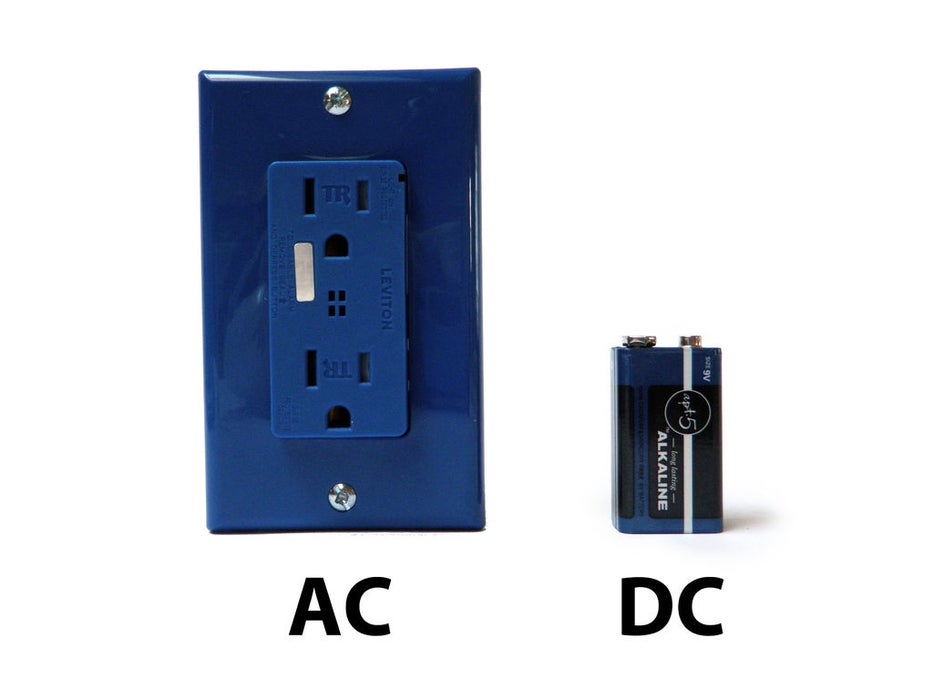
There are two types of electrical signals, those being alternating current (AC), and direct current (DC).
With alternating current, the direction electricity flows throughout the circuit is constantly reversing.
You may even say that it is an alternating direction. The rate of reversal is measured in Hertz, which is the number of reversals per second.
So, when they say that the US power supply is 60 Hz, what they mean is that it is reversing 120 times per second (twice per cycle).
With Direct Current, electricity flows in one direction between power and ground. In this arrangement,
there is always a positive source of voltage and ground (0V) source of voltage. You can test this by reading a battery with a multimeter.
Speaking of voltage, electricity is typically defined as having a voltage and a current rating.
Voltage is obviously rated in Volts and current is rated in Amps. For instance,
a brand new 9V battery would have a voltage of 9V and a current of around 500mA (500 milliamps).
Electricity can also be defined in terms of resistance and watts. We will talk a little bit about resistance in the next step,
but I am not going to be going over Watts in depth. As you delve deeper into electronics you will encounter components with Watt ratings.
It is important to never exceed the wattage rating of a component, but fortunately, that Wattage of your DC power supply can easily be calculated
by multiplying the voltage and current of your power source.
If you want a better understanding of these different measurements, what they mean, and how they relate,
check out this [informative video] on Ohm's Law.
Circuits
A circuit is a complete and closed path through which electric current can flow. In other words, a closed-circuit would allow the flow of electricity between power and ground. An open circuit would break the flow of electricity between power and ground.
Anything that is part of this closed system and that allows electricity to flow between power and ground is considered to be part of the circuit.
Resistance & short circuits
In the circuit above, the motor that electricity is flowing through is adding resistance to the flow of electricity. Thus, all of the electricity passing through the circuit is being put to use.
In other words, there needs to be something wired between positive and ground that adds resistance to the flow of electricity and uses it up. If a positive voltage is connected directly to the ground and does not the first pass through something that adds resistance, like a motor, this will result in a short circuit. This means that the positive voltage is connected directly to the ground.
Likewise, if electricity passes through a component (or group of components) that does not add enough resistance to the circuit, a short will likewise occur (see Ohm's Law video).
Shorts are bad because they will result in your battery and/or circuit overheating, breaking, catching on fire, and/or exploding.
It is very important to prevent short circuits by making sure that the positive voltage is never wired directly to the ground.
That said, always keep in mind that electricity always follows the path of least resistance to ground. What this means is that if you give positive voltage the choice to pass through a motor to ground, or follow a wire straight to ground, it will follow the wire because the wire provides the least resistance. This also means that by using the wire to bypass the source of resistance straight to the ground, you have created a short circuit. Always make sure that you never accidentally connect positive voltage to the ground while wiring things in parallel.
Also, note that a switch does not add any resistance to a circuit and simply adding a switch between power and ground will create a short circuit.
Series Vs. Parallel
There are two different ways in which you can wire things together called series and parallel.
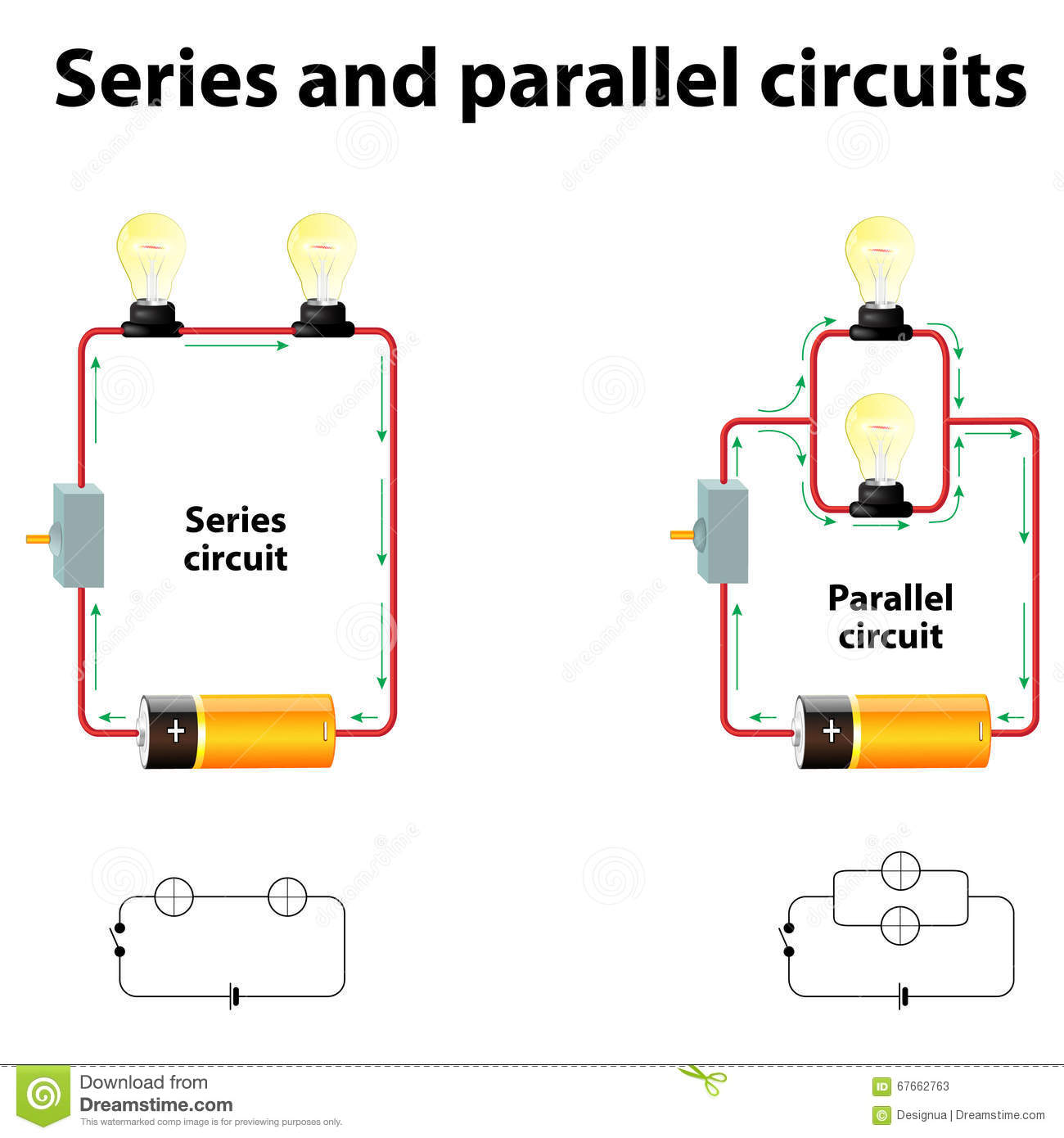
When things are wired in series, things are wired one after another, such that electricity has to pass through one thing, then the next thing, then the next, and so on.
In the left picture, the lightbulbs, switch, and battery are all wired in series because the only path for electricity to flow is from one to the next, and to the next.
When things are wired in parallel, they are wired side by side, such that electricity passes through all of them at the same time, from one common point to another common point
In the next example, the lightbulbs are wired in parallel because the electricity passes through both lightbulbs from one common point to another common point.
If this does not make sense yet, do not worry. When you start to build your own circuits, all of this will start to become clear.
Series and Parallel Circuits have different resistance even with the same components.
In Series Circuits the total resistance Rt=R1+R2
In Parallel Circuits the total resistance will be smaller than Series Circuits: 1/Rt=(1/R1)+(1/R2)
Basic Components
Resistors
As the name implies, resistors add resistance to the circuit and reduce the flow of electrical current. It is represented in a circuit diagram as a pointy squiggle with a value next to it.
The different markings on the resistor represent different values of resistance. These values are measured in ohms.
Resistors also come with different wattage ratings. For most low-voltage DC circuits, 1/4 watt resistors should be suitable.
You read the values from left to right towards the (typically) gold band. The first two colors represent the resistor value, the third represents the multiplier, and the fourth (the gold band) represents the tolerance or precision of the component. You can tell the value of each color by looking at a resistor color value chart.
Or... to make your life easier, you could simply look up the values using a [graphical resistance calculator].
Anyhow... a resistor with the markings brown, black, orange, gold will translate as follows:
1 (brown) 0 (black) x 1,000 = 10,000 with a tolerance of +/- 5%
Any resistor of over 1000 ohms is typically shorted using the letter K. For instance, 1,000 would be 1K; 3,900, would translate to 3.9K; and 470,000 ohms would become 470K.
Values of ohms over a million are represented using the letter M. In this case, 1,000,000 ohms would become 1M.
Capacitors
A capacitor is a component that stores electricity and then discharges it into the circuit when there is a drop in electricity. You can think of it as a water storage tank that releases water when there is a drought to ensure a steady stream.
for more info capacitors
Diodes
Diodes are components which are polarized. They only allow electrical current to pass through them in one direction. This is useful in that it can be placed in a circuit to prevent electricity from flowing in the wrong direction.
more info Diodes
Transistors
A transistor takes in a small electrical current at its base pin and amplifies it such that a much larger current can pass between its collector and emitter pins. The amount of current that passes between these two pins is proportional to the voltage being applied at the base pin.
more info Transistors
Potentiometers
Potentiometers are variable resistors. In plain English, they have some sort of knob or slider that you turn or push to change resistance in a circuit. If you have ever used a volume knob on a stereo or a sliding light dimmer, then you have used a potentiometer.
Potentiometers are measured in ohms like resistors, but rather than having color bands, they have their value rating written directly on them (i.e. "1M"). They are also marked with an "A" or a "B, " which indicated the type of response curve it has.
Potentiometers marked with a "B" have a linear response curve. This means that as you turn the knob, the resistance increases evenly (10, 20, 30, 40, 50, etc.). The potentiometers marked with an "A" have a logarithmic response curve. This means that as you turn the knob, the numbers increase logarithmically (1, 10, 100, 10,000 etc.)
Potentiometers have three legs as to create a voltage divider, which is basically two resistors in series. When two resistors are put in series, the point between them is a voltage that is a value somewhere between the source value and ground.
For instance, if you have two 10K resistors in series between power (5V) and ground (0V), the point where these two resistors meet will be half the power supply (2.5V) because both of the resistors have identical values. Assuming this middle point is actually the center pin of a potentiometer, as you turn the knob, the voltage on the middle pin will actually increase towards 5V or decrease toward 0V (depending which direction that you turn it). This is useful for adjusting the intensity of an electrical signal within a circuit (hence its use as a volume knob).
This is represented in a circuit as a resistor with an arrow pointing towards the middle of it.
If you only connect one of the outer pins and the center pin to the circuit, you are only changing the resistance within the circuit and not the voltage level on the middle pin. This too is a useful tool for circuit building because often you just want to change the resistance at a particular point and not create an adjustable voltage divider. This configuration is often represented in a circuit as a resistor with an arrow coming out of one side and looping back in to point towards the middle.
LEDs
LED stands for light emitting diode. It is basically a special type of diode that lights up when electricity passes through it. Like all diodes, the LED is polarized and electricity is only intended to pass through in one direction.
There are typically two indicators to let you know what direction electricity will pass through and LED. The first indicator that the LED will have a longer positive lead (anode) and a shorter ground lead (cathode). The other indicator is a flat notch on the side of the LED to indicate the positive (anode) lead. Keep in mind that not all LEDs have this indication notch (or that it is sometimes wrong).
Like all diodes, LEDs create a voltage drop in the circuit, but typically do not add much resistance. In order to prevent the circuit from shorting, you need to add a resistor in series. To figure out how large of a resistor you need for optimum intensity, you can use this online LED calculator to figure out how much resistance is needed for a single LED. It is often good practice to use a resistor that is slightly larger in the value than what is returned by [calculator].
Typically, the forward voltage of an LED is between 1.8 and 3.3 volts. It varies by the color of the LED. A red LED typically drops 1.8 volts. For most purposes, the exact value is not critical and you can use 2V for red, yellow and green, or 4V for blue and white LEDs.
The LED current must be less than the maximum permitted for your LED. For standard 5mm diameter LEDs the maximum current is usually 20mA, so 10mA or 15mA are suitable values for many circuits. The current must be in amps (A) for the calculation, to convert from mA to A divide the current in mA by 1000.
You may be tempted to wire LEDs in series, but keep in mind that each consecutive LED will result in a voltage drop until finally there is not enough power left to keep them lit. As such, it is ideal to light up multiple LEDs by wiring them in parallel. However, you need to make certain that all of the LEDs have the same power rating before you do this (different colors often are rated differently).
LEDs will show up in a schematic as a diode symbol with lightning bolts coming off of it, to indicate that it is a glowing diode.
Buttons and Switches
A switch is basically a mechanical device that creates a break in a circuit. When you activate the switch, it opens or closes the circuit. This is dependent on the type of switch it is.
Normally open (N.O.) switches close the circuit when activated.
Normally closed (N.C.) switches open the circuit when activated.
As switches get more complex they can both open one connection and close another when activated. This type of switch is a single-pole double-throw switch (SPDT).
If you were to combine two SPDT switches into one single switch, it would be called a double-pole double-throw switch (DPDT). This would break two separate circuits and open two other circuits, every time the switch was activated.
Batteries and Power Supply
A battery is a container which converts chemical energy into electricity. To over-simplify the matter, you can say that it "stores power."
By placing batteries in series you are adding the voltage of each consecutive battery, but the current stays the same. For instance, a AA-battery is 1.5V. If you put 3 in series, it would add up to 4.5V. If you were to add a fourth in series, it would then become 6V.
By placing batteries in parallel the voltage remains the same, but the amount of current available doubles. This is done much less frequently than placing batteries in series, and is usually only necessary when the circuit requires more current than a single series of batteries can offer.
It is recommended that you get a range of AA battery holders. For instance, I would get an assortment that holds 1, 2, 3, 4, and 8 AA batteries.
Breadboards
OK, first, what's with the name....bread board? Bread, like in food?
Well yes, kind of.
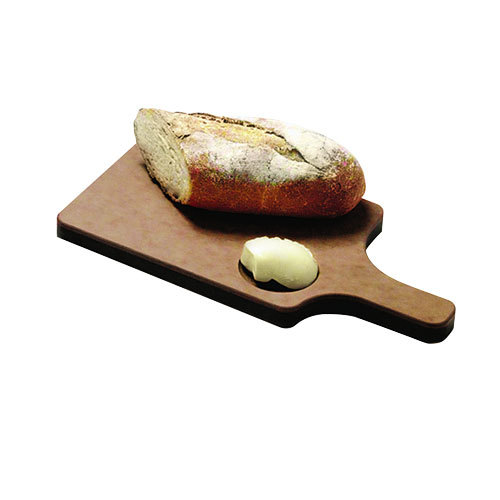
This terminology goes way back in the days.
Generally, you would mount electronic components to a piece of wood (the actual "breadboard"), and do all the wiring with point-point wire and the components just hanging between the various devices.
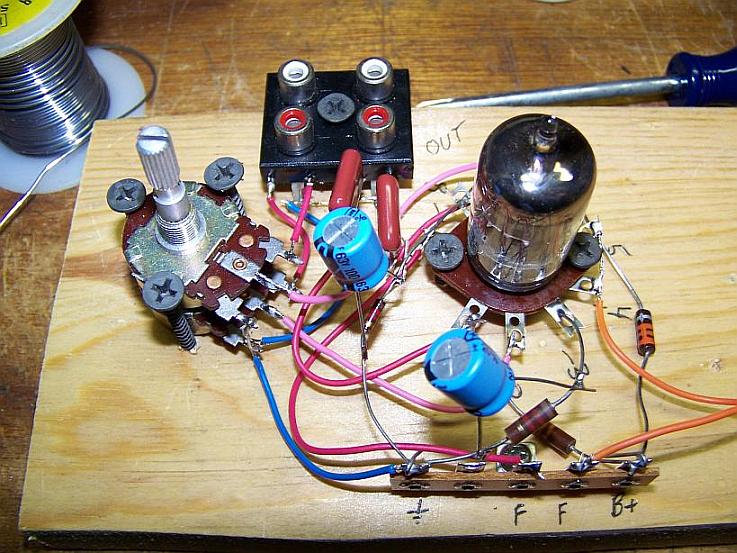
The story goes that an engineer had an idea for a vacuum tube device late one night. Looking around the house, the only base for his prototype that he found was indeed his wife's breadboard, from the breadbox.
A video by the Make magazine people
Ok, but why do we need to breadboard?
Well, they are useful for making temporary circuits and prototyping, and they require absolutely no soldering.
Prototyping is the process of testing out an idea by creating a preliminary model from which other forms are developed or copied,
and it is one of the most common uses for breadboards.
The best way to explain how a breadboard works is to take it apart and see what’s inside.
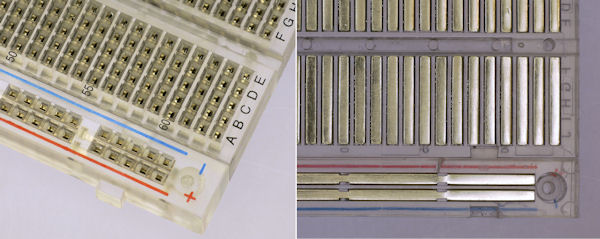
connections lines are connected like this
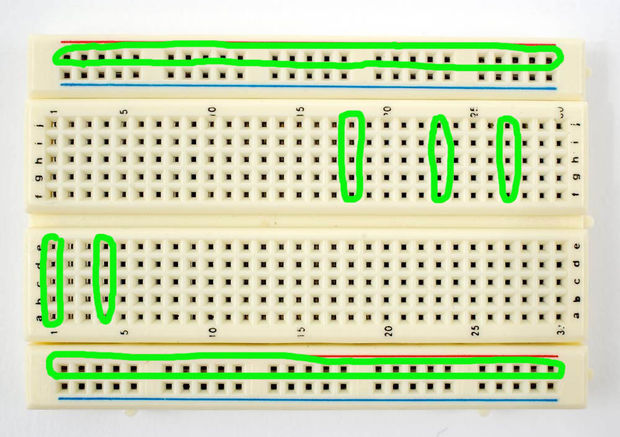
Integrated Circuits
An integrated circuit is an entire specialized circuit that has been miniaturized and fit onto one small chip with each leg of the chip connecting to a point within the circuit. These miniaturized circuits typically consist of components such as transistors, resistors, and diodes. Integrated Circuits
Soft Materials
Intro: This is an introduction to working with soft electronics. Combining and entwining circuits and fabrics. We will go through the fundamental knowledge of electricity and how we can use it in various ways to make soft interfaces.
conductive
When we work with electronics, we obviously need electricity to power our work, so a crucial component of our work are conductive materials, or conductors. Conductors are substances that allow the flow of electrical current through them. The most common and well-known conductors of electrical current are metals. Both conductivity and resistivity are properties of conductors. As we focus on wearables, it will be in our interest to move further than using simply wire, that is most commonly used in electrical circuits and explore other conductive materials.
conductive and resisitive
Simplified explanation: they are opposites!
Resistivity - the amount of opposition to electrical flow
Conductivity - how easy it is for an electrical flow
fabrics
Conductive fabrics can be used as traces and wires are used in a circuit.
It can be cut by hand, lasercut, cut with a vinyl cutter. Lasercutting can leave smokey traces on the material and slightly melted edges. Using a vinyl cutter leaves the fabric cleaner.
Interfacing it to another fabric can be done via interfacing adhesive (such as heat n bond, that gives clean and neat results), fabric glue (it is more difficult to work with in complex shapes), sawing.
thread
Conductive threads are usually manufactured for anti-static, electromagnetic shielding, intelligent textiles, wearable technology, data transfer and heating purposes. Most threads are metalised with an alloy of various metals, which can include silver, copper, tin and nickel. The core is normally cotton or polyester.
Conductive threads are mostly non insulated and sewing them tightly to metal usually makes for a good connection, though this connection tends to loosen over time where movement occurs. One way of avoiding this is to include a squishy material, such as stretch conductive fabric underneath the stitches, or a non-conductive material, so long as it does not obstruct the electrical connection.
velcro
Velcro is the brand name for fabric Hook and Loop fasteners. conductive velcro is highly conductive and good for making switches or connections that might need to be opened and closed.
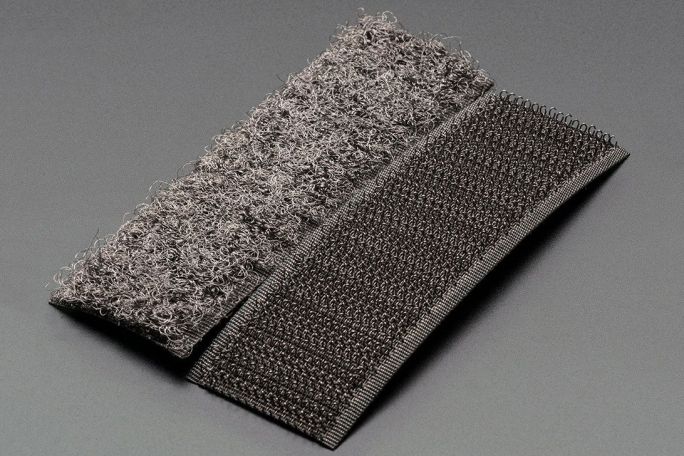
wool
Conductive wool has very fine conductive fibers (steel) mixed with normal wool, or with polyester. It can be used for felting.
tapes and foils
Conductive tapes and foils can be used (as other conductive materials) as traces and wires are used in regular circuits. the most popular and available tapes are copper (on the picture) and aluminium. They can be with an adhesive backing or without. They can be shaped by cutting (by hand, by vinyl cutting).
ink
conductive inks and paints can be difficult to use on fabric, because they lack flexibility once they are dry. However they can be useful in making connection where another solution is impossible.
foam
Resistive foam, ESD foam, black conductive polyurethane foam, dissipative foam
Comes with sensitive electronic chips and components. Available in various densities, soft or stiff. Good for pressure sensing.
play doh
non-conductive
adhesive interfacing
A very good solution for interfacing conductive fabric is Heat n Bond
Even separate pieces of conductive fabric can be glued together and if properly ironed will connect electrically (always check your connections with a multimeter and iron again if there is lack of continuity)

glues
This glue is Flexible and therefore recommended
Resources!
Biggest resource for everything wearable related BIG UP for Kobakant
